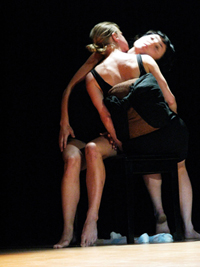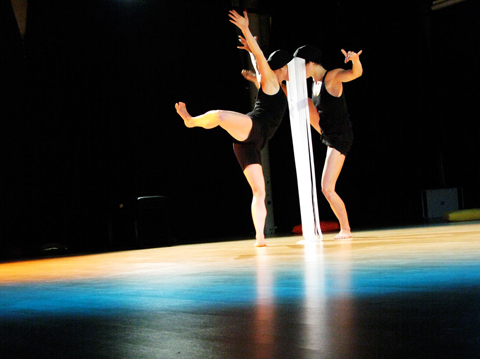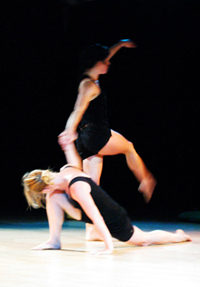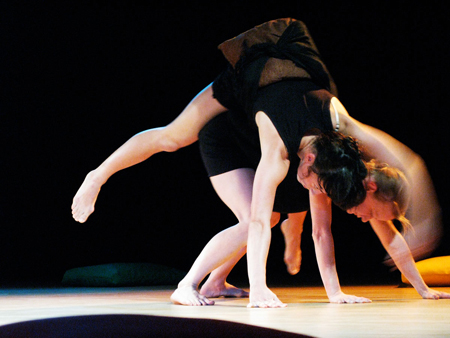


by Bilqis Hijjas
Duod
Evolving Motion, featuring Cathy Seago and Rosalind Noctor
Friday 4 September 2009
Indicine, KLPac
~
Malaysian artists complain that Malaysian audiences like to get things for free. Well, why not? Case in point — Shobana‘s performance of Maya Ravan at KL Convention Centre, tickets starting from RM 153. Verdict from the cognoscenti? Rubbish! Contrast this with Cathy Seago and Rosalind Noctor presenting their work-in-progress, Duod, to an audience sitting on the floor of the Indicine at KLPac — most of whom got there shamefully late, but were still allowed in and even invited to participate in the show. Result? Ah, heaven …
Cathy Seago, lecturer in dance at the University of Winchester and director of the dance company Evolving Motion, and her dancer Ros have been holed up in a studio at KLPac for the last month. They chose to go abroad to develop their work, presumably to get away from distractions, but now they think they might return to Malaysia some day and I really hope they do! Watching such accomplished dancers enjoying each others’ movement is a treat that we enjoy too seldom.
 On Friday night, they performed four sections out of the seven that will exist in the finished work. As the audience shuffled shyly in to find a place on the floor, Ros and Cathy were sitting on a piano stool, necking. And by this I mean not kissing, but the movement that you sometimes observe in giraffes or cats, a rubbing of the head and neck against each other, leaning, entwining, unwinding. From here they progressed to a slow deliberate crawling on the floor, still firmly attached to each other, but with a sense of sleepwalking in the dangling, leaning, rocking and shifting of weight. For a moment they engaged like wrestlers, the tops of the heads pressed against each other, pushing, now one giving way, now another.
On Friday night, they performed four sections out of the seven that will exist in the finished work. As the audience shuffled shyly in to find a place on the floor, Ros and Cathy were sitting on a piano stool, necking. And by this I mean not kissing, but the movement that you sometimes observe in giraffes or cats, a rubbing of the head and neck against each other, leaning, entwining, unwinding. From here they progressed to a slow deliberate crawling on the floor, still firmly attached to each other, but with a sense of sleepwalking in the dangling, leaning, rocking and shifting of weight. For a moment they engaged like wrestlers, the tops of the heads pressed against each other, pushing, now one giving way, now another.
The second section began with the dancers donning tight caps with a long white fringe over the face that reached down to the floor. The impression was half burkha, half Chinese-opera, a swaying white sculpture through which we could not see, but sensed we could be seen. Joined again, the dancers shifted from one slow one-legged position to another. At length they broke apart, whirling with arms and legs flung out — Ros like a dancer, but Cathy as if she were blind and clutching.

The third section lightened the mood. Like a game, hiding and seeking around the audience, the dancers scuttled to sit or stand next to each other, then rebounded away. The play moved faster and faster, the dancers stabbing limbs through each other’s negative spaces, bouncing off hips and backs, occasionally colliding, copying and following, swinging with immense momentum. The speed of their improvisation was impressive, born of long hours spent together in the studio and a deep inexpressible understanding of each other’s weight and physical habits.
In one particularly telling instance, Cathy made a slight miscalculation going into an inversion and hit Ros on the mouth with the end of her foot. The audience shared a in-breath of collective horror, but a few seconds later the dancers smiled at each other from the midst of their movement, and we knew that everything was going to be alright. The smile, of course, was for our benefit, not for theirs. Ros already knew that Cathy hadn’t hurt her, Cathy knew she hadn’t hurt Ros, and both of them knew that the other knew they knew!
 In the fourth section, the dancers returned to a more businesslike mode with a choreographed phrase marked with moments of contact. It was intricate and visually interesting, but after the frenzy of the previous section it seemed like the exhale, the cool down. Afterwards, the dancers invited the audience to participate in a little experiment, holding the ends of long strands of raffia and passing them around the circle, while in the centre Ros became entangled.
In the fourth section, the dancers returned to a more businesslike mode with a choreographed phrase marked with moments of contact. It was intricate and visually interesting, but after the frenzy of the previous section it seemed like the exhale, the cool down. Afterwards, the dancers invited the audience to participate in a little experiment, holding the ends of long strands of raffia and passing them around the circle, while in the centre Ros became entangled.
I have described the movement of this work in some detail because — although Ros and Cathy have an established conceptual structure which they are exploring in their work, revolving around the seven stages of tension theorised by Jacques LeCoq — to me the highlight of the event was observing the sheer physical facility of the two artists and the kaleidoscopic delight of their bodies in combination. So it made more sense to me when Cathy and Ros remarked that their initial starting point in developing this work was that they really wanted to dance together, and they wanted to dance a lot.
It made me think that, within the right framework (one carefully censorious of self-indulgent wanking, for example), sometimes it is enough just to revel in the joyousness of two dexterous bodies at play. Nothing more is needed. There was an element of watching the cavorting of sea lions or dolphins, perhaps, if dolphins were familiar with fractal theory. Especially during the improvised section, you could see the dancers processing information and making split-second responses, weighing options and diving for new ideas, all the time moving faster than many of us will ever have the ability to move.

The finished work will be performed with elaborate costumes, designed by Ros, playing a major part, but it was nice to see the work in progress in a rawer state, unencumbered by additional layers of meaning. Nevertheless, I would be happy to see Duod in any state again, and I really hope that Evolving Motion will be able to bring their finished work back to KL for a proper performance. But I count myself very lucky to have been among the few to see them share their work-in-progress, and all of it, you see, for free!
(BH)
~
Images by Foo Chiwei.
Bilqis Hijjas’s dancerly reviews may also be found at KL Dance Watch.
Sorry, the comment form is closed at this time.
good to see you back in Arteri, Bilqis! As always, great review and write up.